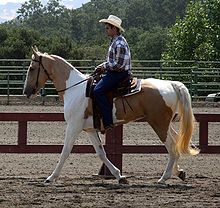Type the name of the breed you're looking for below
[wpdreams_ajaxsearchlite] Don't see the breed your're looking for? Click here and let us know!
Spotted Saddle Horse
| Country Of Origin | United States of America |
| History and Background | The Spotted Saddle Horse is a horse breed from the United States that was developed by crossing Spanish-American type gaited pinto ponies with gaited horse breeds, such as the Tennessee Walking Horse. The result was a colourful, smooth-gaited horse, used in the show ring and for pleasure and trail riding. Two registries have been created for the breed, one in 1979 and the other in 1985. The two have similar registration requirements, although one has an open stud book and the other is slightly more strict with regard to parentage requirements, having a semi-closed stud book. The Spotted Saddle Horse is a light riding horse, always pinto in colour. Solid-coloured foals from registered parents may be registered for identification purposes, so their pinto-colored foals have documented parentage. They always perform an ambling gait, rather than a trot, in addition to the gaits of walk and canter, performed by all breeds. The Spotted Saddle Horse developed from small gaited pinto ponies of Spanish ancestry. These were crossed with larger American breeds such as the Morgan and Standardbred, developed after the American Revolution, to increase size while retaining colouration and the desired gait. After the American Civil War, additional gaited blood was added, with contributing breeds including the Tennessee Walking Horse, Missouri Fox Trotter, Paso Fino and Peruvian Paso. Mustangs from the American West were also incorporated. Originally developed in central Tennessee, and selectively bred for pinto colouration, they were used for general pleasure and trail riding. There are two breed registries for the Spotted Saddle Horse. In 1979, the National Spotted Saddle Horse Association (NSSHA) was organized in Murfreesboro, Tennessee. The association focuses on promoting naturally-gaited saddle horses with pinto coloration. The NSSHA is adamant about disallowing cruel and inhumane training and showing practices, including soring, sometimes seen in other elements of the Spotted Saddle Horse industry, and prohibited by the Horse Protection Act of 1970 (HPA). The NSSHA also bans the use of action devices (such as chains or other weights around the pasterns) and performance packages (stacks of pads attached to the shoe, sometimes weighted or used to conceal abusive shoeing practices) in their shows, which goes beyond the protection afforded by the HPA. In 1985, the Spotted Saddle Horse Breeders and Exhibitors Association (SSHBEA) was formed, headquartered in Shelbyville, Tennessee. The SSHBEA is recognized as a "Horse Industry Organization" (HIO) under the HPA, and occasionally sees violations of the HPA at their shows. Violations of the HPA are addressed in the SSHBEA rulebook, and violations can result in disqualifications from individual shows or extended suspensions from Spotted Saddle Horse showing. Today, the Spotted Saddle Horse is seen at horse shows, as well as being used for pleasure and trail riding. |
| Use Today | Show horse, Riding horse |
| Height | 14.3 to 16 hands (59 to 64 inches, 150 to 163 cm) |
| Weight | 900 to 1,100 pounds (410 to 500 kg) |
| Colour | All colours but must possess pinto spotting patterns. |
| Characteristics | The head is refined, with a straight or slightly convex facial profile. The neck is muscular, with a slight arch, leading into long, sloping shoulders and a muscular chest. The back is short and the hindquarters muscular and broad. The croup is slightly sloping and rounded, with a high-set tail. The ideal Spotted Saddle Horse resembles a "smaller, slightly stockier Tennessee Walking Horse". Pinto colouration is required, with white spots on a background any equine coat colour. Overo and tobiano are the two most common patterns, and the coverage of the white spots can range from minimal to almost complete. |
| Personality and Temperament | Even tempered, docile, friendly and pleasant |



